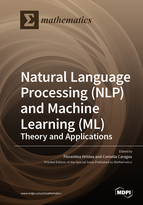Natural Language Processing (NLP) and Machine Learning (ML)—Theory and Applications
A special issue of Mathematics (ISSN 2227-7390). This special issue belongs to the section "Mathematics and Computer Science".
Deadline for manuscript submissions: closed (31 January 2022) | Viewed by 43030
Special Issue Editors
Interests: artificial intelligence (AI); knowledge representation; natural language processing; computational linguistics; human language technology; computational statistics applied in natural language processing; data analysis
Special Issues, Collections and Topics in MDPI journals
Special Issue Information
Dear Colleagues,
Natural language processing (NLP) is one of the most important technologies in use today due to the large and growing amount of online text that needs to be understood to fully ascertain its enormous value. Although many machine learning models have been developed for NLP applications, recently, deep learning approaches have achieved remarkable results across many NLP tasks. This Special Issue focuses on the use and exploration of current advances in machine learning and deep learning for NLP topics including (but not limited to) information extraction, information retrieval and text mining, text summarization, computational social science, discourse and dialog systems, interpretability, ethics in NLP, linguistic theories, NLP for social good. This Special Issue provides a platform for researchers from academia and industry to present their novel and unpublished work in the domain of natural language processing and its applications, with a focus on applications of machine learning and deep learning in the broad spectrum of research areas that are concerned with computational approaches to natural language. This will help to foster future research in NLP and related fields.
Prof. Dr. Florentina Hristea
Prof. Dr. Cornelia Caragea
Guest Editors
Manuscript Submission Information
Manuscripts should be submitted online at www.mdpi.com by registering and logging in to this website. Once you are registered, click here to go to the submission form. Manuscripts can be submitted until the deadline. All submissions that pass pre-check are peer-reviewed. Accepted papers will be published continuously in the journal (as soon as accepted) and will be listed together on the special issue website. Research articles, review articles as well as short communications are invited. For planned papers, a title and short abstract (about 100 words) can be sent to the Editorial Office for announcement on this website.
Submitted manuscripts should not have been published previously, nor be under consideration for publication elsewhere (except conference proceedings papers). All manuscripts are thoroughly refereed through a single-blind peer-review process. A guide for authors and other relevant information for submission of manuscripts is available on the Instructions for Authors page. Mathematics is an international peer-reviewed open access semimonthly journal published by MDPI.
Please visit the Instructions for Authors page before submitting a manuscript. The Article Processing Charge (APC) for publication in this open access journal is 2600 CHF (Swiss Francs). Submitted papers should be well formatted and use good English. Authors may use MDPI's English editing service prior to publication or during author revisions.
Keywords
- Natural language processing
- Machine learning
- Deep learning







